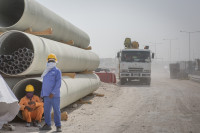Opinion
The Nepse soars
The newly issued monetary policy partly explains the bullish trend of the stock market
Bishnu Prasad Bhandari
The Nepal Stock Exchange (Nepse) created history on August 20 by crossing the 1,200-point mark. The upsurge in the Nepse is a subject for research though the monetary policy recently issued by the Nepal Rastra Bank seems to have played an important role in the upward movement in stock prices.
Rise and fall
Stock prices are determined by the demand and supply principle. If the price of shares of a particular company increases, it means that there is more demand for them and the players in the stock market want to buy them. If the price of shares of a company decreases, it means that there is less demand for them and the players in the stock market want to sell them. It is important to note that stock prices are not set by a single person; it is the market that sets them. It is the sentiments, attitudes and expectations of investors that ultimately affect stock prices. People buy stocks only when they think the prices will rise in the future and earn them a profit. Similarly, they sell their stocks to manage their losses when they feel that prices will fall in the future.
Therefore, higher earnings, new products, mergers, acquisitions, company buyouts and market makers manipulating stock, insider trading, new regulations and laws and loss of competitors are a few reasons which lead to an increase in stock prices. Similarly, lower earnings, institutional selling, bad press, bankruptcy, recession, profit by competitors, management changes and lawsuits are some of the reasons which contribute to lowering stock prices. In addition, economic data, geopolitical events, market sentiment and central bank announcements are some of the factors which impact stock prices.
The actions of big players in the market also play an important role in influencing stock prices. When investors with a large amount of capital move in or out of a company, they can single-handedly move the price of its stock up or down by a few points, depending on how fast they move the capital and the size of the company in question. Furthermore, earnings growth, future earnings and dividends are other long-term factors which cause stock prices to rise or fall. The more profits a company makes and the better margins it produces, the more expensive its stock becomes.
Likewise, when a company not only increases its earnings but increases them faster than it did previously, it is a signal that the company might be able to sustain this growth and grow exponentially. Similarly, if a company can pay dividends to its shareholders, its earnings influence the price of its stock. A revision in the interest rates by the central bank is also one of the factors influencing stock prices. If the interest rate is lowered, businesses can borrow money at a lower interest rate, produce more and increase their sales which will have a positive impact on their stock prices.
Bullish trend
Going back to the spike in the Nepse, the Monetary Policy 2014-15 seems to have played a major role. The policy requires the BFIs to increase their paid-up capital—commercial banks are required to increase their paid-up capital to Rs 8 billion, development banks to Rs 2.5 billion and financial institutions to Rs 800 million within two years. One option available to BFIs is issuing bonus and right shares, and investors may expect them to allocate bonus shares and preferential shares to them.
The Nepal Rastra Bank has barred BFIs from issuing cash dividends until the new paid-up capital requirement is fulfilled. So the expectation of investors of an increase in share prices with the allocation of bonus and right shares seems to have caused a positive impact. Likewise, as BFIs have an adequate amount of liquidity investors are borrowing money from such institutions at a cheaper rate and investing in stocks. This has had an impact on the share prices too. The progress in constitution writing has also made Nepalis hopeful of a stable economy and this could be another reason for the positive movement of the Nepse.
Regardless of all these reasons, Nepal’s stock market, at times, runs on rumours and myths. So, rather than basing one’s decision on a relative, neighbour or friend investing in a particular share, it is prudent to make a proper study, analysis and research before entering the stock market. It is better to seek advice from a professional, if required. A good investor makes a decision by considering the risks associated with it, and one can always build on the correct decision and diversify one’s portfolios. But, of course, if there is no risk, no return can be ensured. Even so, taking risks cautiously gives rise to a beneficial situation for investors.
Bhandari is a chartered accountant




 9.12°C Kathmandu
9.12°C Kathmandu









%20(1).jpg&w=300&height=200)

